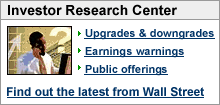|
Retail investors rush in. Uh oh.
Individuals are jumping back into the market this year, which could be a bad sign for the market. But wait...
NEW YORK (CNNMoney.com) - Individual investors are moving back into stocks at the fastest pace in years. Uh oh. The stock market is already struggling with uncertainty about when the Federal Reserve's interest rate hiking campaign will end, an expected slowdown in economic growth in the second half, higher energy prices, rising Treasury bond yields and other inflationary factors. The last thing it needs is for retail investors to rush in.
Why? Because as history makes clear, by the time individual investors are jumping in, that's the time the bull market is pretty much over. Individual investors are often the last hurrah, when most of the advance has already happened. (For one recent example see the end of the Internet bubble, circa 2000). As Barry Ritholtz, chief market strategist at Ritholtz Research, wrote in a recent note to clients: "This is how sucker rallies draw people in. Once the most naive and least informed buy in, who else is left to drive prices higher?" But that's not always the case, said William Hummer, a money manager and principal at Wayne Hummer Inc. "The established theory is that usually the individual's timing is wrong, but that's a big generalization," he said. "I've seen cases where they are right on time and this may be one of them." Hummer said that when individual investors' renewed interest is accompanied by more activity in lower-priced stocks with an emphasis on quick gains, that's when there is some concern. But he says the recent trend does not seem to be that way. Small investors seem to remain focused on the long term. The latest move is related more to getting out of real estate and other investments and moving back into stocks and mutual funds. "We're not going back to 1999," Hummer said. "That's when you get worried, not when the retail investor is taking measured steps." Where's the money going?
There has been a pick up in interest lately. "To the extent that there's more people involved in the daily trading of the markets, it's a good thing," said John Burnham, portfolio manager at Burnham Securities, noting that nowadays trading is dominated by huge institutional investors as well as hedge funds. He said seeing more individuals come back is a good thing. As a recent Wall Street Journal article pointed out, discount brokers in particular saw a big pickup in the number of individual trades in January. In addition, money flowed into stock mutual funds in January at brokers such as Charles Schwab at the fastest pace in nearly six years. "If the retail investor has picked up, as you've seen in January, that's a positive, in that you want consumers to be saving more and investing," said Timothy Ghriskey, chief investment officer at Solaris Asset Management. "But you never want to be the last one in and too often that's the case." Case in point: much of the money flooding the market has been chasing international funds, according to AMG, a tracker of money inflows. International funds were among the best performers last year. Select country funds still offer good buying opportunities, Burnham said. But some have run up so much in recent months that they may be ripe for a correction, and many individual investors may get hurt. For example, the India Fund (Research), which invests in Indian stocks, soared 32 percent in January and February, hitting an all-time high. But in the last week, it's already lost 10 percent of its value. Bull getting old?
The bull market turned three last October, making it one of the oldest on record, and perhaps suggesting its days are numbered. "Most bull markets don't last as long as this one has," said Jeffrey Hirsch, editor in chief of the Stock Trader's Almanac. He said as measured by the Dow industrials, only five bull markets in history have lasted longer than the current one, which is nearly 3-1/2 years old. Additionally, the S&P 500 is not far from a 4-1/2 year high and the Dow hit a more than four-year high last month. Since then both indexes have struggled. These are all among the factors suggesting that the stock market is nearing a top, Hirsch added. He said that there have been a number of March tops historically, that were then followed by a big selloff. The most recent example is 2002 in which the market hit its peak in March then began to back off until bottoming out in October of that same year. That could happen this year too. In fact, many analysts have been calling for the market to bottom out sometime in the second half anyway. Such a move would be consistent with the theory that the market follows the four-year cycle of the presidency, and that year two is usually the worst and the most likely time to see a bottom. However, such selloffs have historically led to good buying opportunities for investors, the analysts said, such as in 2002, when the October bottom paved the way for the current 3-1/2 year bull market. __________________
Are you worried about your mortgage? With the real estate market slowing and interest rates on the rise, it may be time to rethink your loan. For an upcoming story, MONEY Magazine is looking for individuals and families in need of advice. For consideration, please e-mail your story in detail to realestate@moneymail.com. |
|



